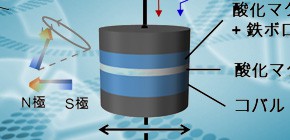
Development of spin-torque diodes with radio frequency detection sensitivity three times that of semiconductor diodes
Step to new applications for spintronic devices
A joint group of researchers at the Graduate School of Engineering Science , Osaka University , and researchers at the Nanospintronics Research Center , National Institute of Advanced Industrial Science and Technology ( AIST ) succeeded in developing a spin-torque diode possessing higher performance than that of a semiconductor diode by using nanometer-sized magnets.
Researchers from the Graduate School of Engineering Science, Osaka University, were: Shinji MIWA (Assistant Professor), ISHIBASHI Shota (then in the 2nd year of his first-term doctoral program), Yoshishige SUZUKI (Professor), Dr. Hiroyuki TOMITA (Researcher), Eiichi TAMURA (Specially Appointed Professor), Ken ANDO (then in the 2nd year of his first-term doctoral program), and Norikazu MIZUOCHI (Associate Professor).
Researchers from the Nanospintronics Research Center, National Institute of Advanced Industrial Science and Technology (AIST), were: Takayuki NOZAKI (Chief Fellow), Takeshi SARUYA (currently Canon Anelva Corporation), KUBOTA Hitoshi (Research Team Leader), Kei YAKUSHIJI (Chief Fellow), TANIGUCHI Tomohiro (Researcher), IMAMURA Hiroshi (Research Team Leader), Akio FUKUSHIMA (Vice director, Research Center), and Shinji YUASA (Director, Research Center).
Spin-torque diodes are expected to be used in high-frequency electronic devices such as communication devices, radio frequency identification tags, and in-vehicle radar systems because of their high sensitivity, small size, high-speed tuning, low resistance, and frequency selectivity. Spintronics technology has already been used for magnetic hard disk drives and magnetoresistive random access memory (MRAM). The development of spin-torque diodes will accelerate the application of spintronics devices in high-frequency electronic fields. Heretofore, semiconductor diodes have been used for detecting microwaves used by mobile phones; however, the radio frequency detection sensitivity of semiconductors is said to be approaching its theoretical limitations. If so, it will be difficult to improve performance.
Spin-torque diodes operate in accordance with principles proposed by this joint group in 2005 and those principles are totally different from those of semiconductors; however, their performance has been lower than that of semiconductor diodes.
However, this time, by using nonlinear ferromagnetic resonance, this joint group significantly increased the performance of the spin-torque diodes, demonstrating a threefold radio frequency detection sensitivity over that of the semiconductor diodes at a room temperature. This group has also found that, by downsizing, this new type of diode was able to enhance the signal-to-noise ratio, one of the performance indexes.
Abstract
Highly sensitive microwave devices that are operational at room temperature are important for high-speed multiplex telecommunications. Quantum devices such as superconducting bolometers possess high performance but work only at low temperature. On the other hand, semiconductor devices, although enabling high-speed operation at room temperature, have poor signal-to-noise ratios. In this regard, the demonstration of a diode based on spin-torque-induced ferromagnetic resonance between nanomagnets represented a promising development, even though the rectification output was too small for applications (1.4 mV mW−1). Here we show that by applying d.c. bias currents to nanomagnets while precisely controlling their magnetization-potential profiles, a much greater radiofrequency detection sensitivity of 12,000 mV mW−1 is achievable at room temperature, exceeding that of semiconductor diode detectors (3,800 mV mW−1). Theoretical analysis reveals essential roles for nonlinear ferromagnetic resonance, which enhances the signal-to-noise ratio even at room temperature as the size of the magnets decreases.
Figure 1

Figure 2


Figure 3
To learn more about this research, please read the full research report entitled " Highly sensitive nanoscale spin-torque diode " at this page of the Nature Materials website.
Related link :

